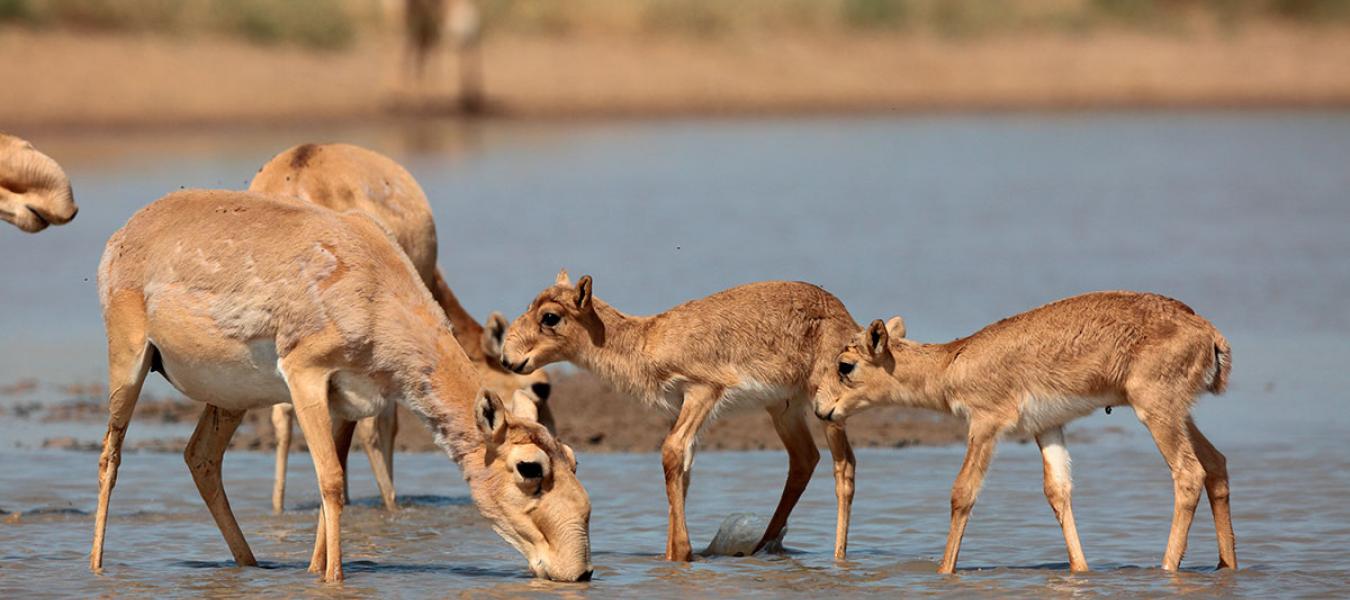
The role of international institutions in the restoration of saiga antelope populations
Irina Novak, biodiversity@tut.by
Freiburg University, Germany
Introduction
An important milestone in improving saiga population status was the entering into force of the Memorandum of Understanding concerning Conservation, Restoration and Sustainable Use of the Saiga Antelope (the Saiga MoU), which was signed by all range states and is coordinated by the Convention on Migratory Species. I explored the MoU's role in the restoration of saiga populations; the results may be useful for restoration of other migratory species.
Theoretical basis
The study is based on regime theory, which investigates the functioning of international institutions. It understands institutions as rules, law and norms that define "rules of the game". International institutions that are created to address a specific problem (like the saiga MoU) form an international regime. To put the provisions of an international regime into practice, additional mechanisms are developed, which influence the actions of national agencies, NGOs, scientific institutions, individual experts, etc.
Methods
I researched the saiga conservation process that unfolded between 1994 and 2016, by analysed the documents prepared for the meetings of signatories to the Saiga MoU, the documents produced by CMS, CITES and the IUCN, Saiga News articles, and publications in scientific journals. Interviews with saiga conservation were a key source of information.
Results
Several stages can be distinguished in the international actions for saiga conservation and restoration. The first stage was the late 1990s to 2002, focused on the formulation of the international regime's provisions. It led up to the international meeting for saiga conservation that was held from 5th to 10th May 2002 in Elista, the Republic of Kalmykia. (http://biodiversity.ru/programs/saigak/meeting.html). The period from 2002 to 2006 involved negotiations with the official representatives of the saiga range countries, culminating in the signing of the Saiga MoU and official formation of the international regime for saiga conservation. From 2006 until 2016 was a period of the regime's geographical and taxonomic extension as well as coordination between many cooperating organizations.
I next focussed on the three saiga populations in Kazakhstan; the Ural, Betpak-Dala and Ustiurt populations. The implementation of measures for their conservation can also be divided into several stages. The initial phase lasted from the 1990s until 2003, during which national hunting bans were introduced and NGOs started their first conservation projects. The next three years were a phase of transformation when the first national programme for saiga conservation was developed and the funding of anti-poaching activities increased. Simultaneously, the number of initiatives implemented by NGOs was growing and the Altyn Dala Conservation Initiative was formed (ADCI http://acbk.kz/ru/pages/6339.html). Thus, the approach to the problem changed significantly in that period, with active conservation measures starting.
The next period was approximately from 2007 to 2010. This was a time of growth and strengthening of the activities implemented by all involved actors, mostly aimed at fighting poaching as the main threat to the saiga. Since the early 2010s, however, additional threats have emerged; the mass mortality events of 2010-2013 and 2015 and the construction of linear infrastructure on the saiga's migratory routes, including the border fence between Kazakhstan and Uzbekistan. This period can be described as a phase of joint responses, as many actors jointly developed and implemented urgent responses to these problems.
Analysis
The development and elaboration of the international regime for saiga conservation enabled mechanisms to develop that became important components of the saiga conservation process. The CMS's Overview Report on the saiga's conservation status regularly presents updated information about the species' state throughout its range and its most urgent threats. The Medium-Term International Work Programme is agreed every five years based on the Overview Report. This Work Programme, in its turn, serves as a common framework that allows the actors to coordinate their activities and thus increase their effectiveness.
The development of communication and accountability tools is also a result of the functioning of international institutions. These include national and project reports as well as the publication Saiga News. Regular information exchange helps the people involved to learn from each other's experience and motivates them to achieve better results.
No less important is the contribution of international institutions to the development of measures to control disease outbreaks and mitigate the negative consequences of linear infrastructure development. This includes involving experts, searching for funding, support for research and development of solutions.
One of the key results is the contribution of international institutions to problem framing, or understanding the decrease in saiga numbers as an urgent social and ecological problem. That was facilitated by listing the species as critically endangered on the IUCN Red List. Finally, the organization of regular meetings under the MoU supports the work of the informal saiga conservation community by increasing cooperation and helping them to combine efforts for implementation of joint projects. The recent decision about the extension of the ADCI in Kazakhstan to cover all three populations is among the most striking examples of such collaboration.
Thus, my analysis demonstrates that the functioning of international institutions is one of the key factors that supports saiga conservation. Important factors affecting this process include; the potentially high economic significance of the species, the timely start of research into the species and raising the alarm about the problem of its rapid decline; and the active work of the many actors, including state agencies, NGOs, research institutions, experts.
I suggest that it would be worthwhile exploring the possibility of further increasing the number of participants in the saiga conservation process, firstly by increasing the direct involvement of local people.
In order to receive the full report of the study, please contact biodiversity@tut.by.
